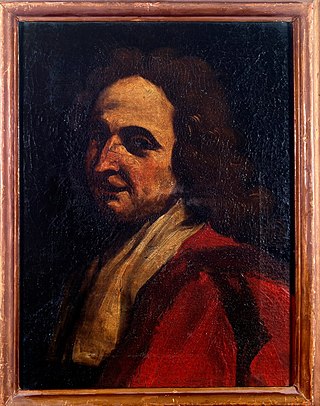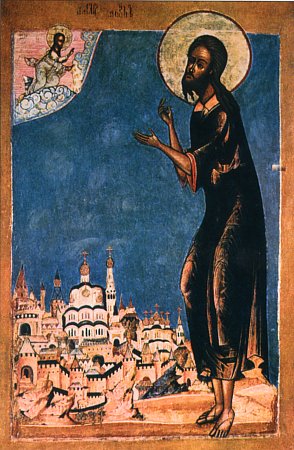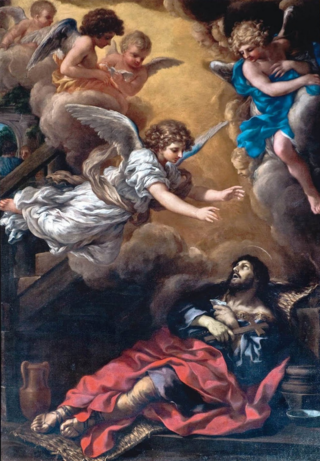
Pope Clement IX, born Giulio Rospigliosi, was head of the Catholic Church and ruler of the Papal States from 20 June 1667 to his death in December 1669.

Stefano Landi was an Italian composer and teacher of the early Baroque Roman School. He was an influential early composer of opera, and wrote the earliest opera on a historical subject: Il Sant'Alessio (1632).

Saint Alexiusof Rome or Alexius of Edessa, also Alexis, was a fourth-century Greek monk who lived in anonymity and is known for his dedication to Christ. Two versions of his life exist, one in Syriac and the other in Greek.

The Palazzo Barberini is a 17th-century palace in Rome, facing the Piazza Barberini in Rione Trevi. Today, it houses the Galleria Nazionale d'Arte Antica, the main national collection of older paintings in Rome.

Francesco Barberini was an Italian Catholic Cardinal. The nephew of Pope Urban VIII, he benefited immensely from the nepotism practiced by his uncle. He was given various roles within the Vatican administration but his personal cultural interests, particularly in literature and the arts, meant that he became a highly significant patron. His secretary was the antiquarian Cassiano dal Pozzo who was also a discerning patron of the arts. Francesco was the elder brother of Cardinal Antonio Barberini and Taddeo Barberini who became Prince of Palestrina.
The year 1632 in music involved some significant events.

Max Emanuel Cenčić is a Croatian countertenor. He was a member of the Vienna Boys' Choir.

Giacinto Gimignani was an Italian painter, active mainly in Rome, during the Baroque period. He was also an engraver of aquaforte.
The year 1631 in music involved some significant events.

Marco Marazzoli was an Italian priest and Baroque music composer.
L'Egisto, ovvero Chi soffre speri is a 1637 commedia musicale, a type of early Italian comic opera, in a prologue and three acts with music by Virgilio Mazzocchi and a libretto by Giulio Rospigliosi, based on Giovanni Boccaccio's Il decamerone.
Orfeo (Orpheus) is an opera in three acts, a prologue and an epilogue by the Italian composer Luigi Rossi. The libretto, by Francesco Buti, is based on the myth of Orpheus and Eurydice. Orfeo premiered at the Théâtre du Palais-Royal in Paris on 2 March 1647. It was one of the earliest operas to be staged in France.

Il Palazzo incantato or Il Palagio d’Atlante, overo La Guerriera Amante, or also Lealtà con valore is an opera in a prologue and three acts by the Italian composer Luigi Rossi. The libretto, by Giulio Rospigliosi, the future Pope Clement IX, is based on Ariosto's Orlando furioso. It was first performed in Rome in a lavish production at the Teatro delle Quattro Fontane on 22 February 1642. Rossi was criticised for giving too much music to his friend, the castrato Marc'Antonio Pasqualini, who played Bradamante, at the expense of the other roles. Some of the highly complicated stage machinery failed to work during the performance. Revived by Opera Dijon in a January 2021 online production.

The Teatro delle Quattro Fontane, also known as the Teatro Barberini, was an opera theatre in Rome, Italy, designed by Gian Lorenzo Bernini and built in 1632 by the Barberini family. From 1632 to 1637 it was located in a large room inside the Palazzo Barberini at the Quattro Fontane. In 1639, it was moved to a new, free-standing building, northeast of the palace and adjacent to the garden. By 1830, the theatre had closed, and the building was used for other purposes. It was demolished in 1932.

Marco Antonio Pasqualini was an Italian castrato opera singer who performed during the Baroque period. He has been described as "the leading male soprano of his day". He was also a composer, having written more than 250 arias and cantatas.
Loreto Vittori was an Italian castrato and composer. From 1622 until his death, he was a mezzo-soprano singer in the papal chapel in Rome.

Xavier Sabata Corominas is a Spanish operatic countertenor.
Odoardo Ceccarelli was an Italian singer, composer, and writer prominent in the Sistine Chapel Choir and the Barberini court. Described from the beginning of his career as both a tenor and a bass, he created roles in several operas, including Fileno in Michelangelo Rossi's Erminia sul Giordano and Orlando in Luigi Rossi's Il palazzo incantato.
Sant'Alessio may refer to:

The Death of Saint Alexius or Saint Alexius Dying is a c.1638 oil on canvas painting by Pietro da Cortona in the Saint Alexis chapel in the Girolamini, Naples. It shows the dying saint Alexius of Rome holding a letter welcomed by angels — he had left his family and returned to them at the moment of his death, with them only recognising him thanks to the letter addressed to them.













